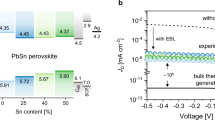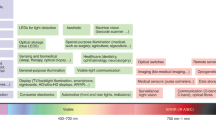Abstract
Organolead trihalide perovskite is an emerging low-cost, solution-processable material with a tunable bandgap from the violet to near-infrared, which has attracted a great deal of interest for applications in high-performance optoelectronic devices. Here, we present hybrid perovskite single-crystal photodetectors that have a very narrow spectral response with a full-width at half-maximum of <20 nm. The response spectra are continuously tuned from blue to red by changing the halide composition and thus the bandgap of the single crystals synthesized by solution processes. The narrowband photodetection can be explained by the strong surface-charge recombination of the excess carriers close to the crystal surfaces generated by short-wavelength light. The excess carriers generated by below-bandgap excitation locate away from the surfaces and can be much more efficiently collected by the electrodes, assisted by the applied electric field. This provides a new design paradigm for a narrowband photodetector with broad applications where background noise emission needs to be suppressed.
This is a preview of subscription content, access via your institution
Access options
Subscribe to this journal
Receive 12 print issues and online access
$209.00 per year
only $17.42 per issue
Buy this article
- Purchase on Springer Link
- Instant access to full article PDF
Prices may be subject to local taxes which are calculated during checkout




Similar content being viewed by others
References
Dandin, M., Abshire, P. & Smela, E. Optical filtering technologies for integrated fluorescence sensors. Lab Chip 7, 955–977 (2007).
Higashi, Y., Kim, K.-S., Jeon, H.-G. & Ichikawa, M. Enhancing spectral contrast in organic red-light photodetectors based on a light-absorbing and exciton-blocking layered system. J. Appl. Phys. 108, 034502 (2010).
Cicek, E., McClintock, R., Cho, C. Y., Rahnema, B. & Razeghi, M. AlxGa1–xN-based back-illuminated solar-blind photodetectors with external quantum efficiency of 89%. Appl. Phys. Lett. 103, 191108 (2013).
Sobhani, A. et al. Narrowband photodetection in the near-infrared with a plasmon-induced hot electron device. Nature Commun. 4, 1643 (2013).
Konstantatos, G. et al. Hybrid graphene–quantum dot phototransistors with ultrahigh gain. Nature Nanotech. 7, 363–368 (2012).
Kim, D.-H. et al. A high performance semitransparent organic photodetector with green color selectivity. Appl. Phys. Lett. 105, 213301 (2014).
Ren, P. et al. Band-selective infrared photodetectors with complete-composition-range InAsxP1–x alloy nanowires. Adv. Mater. 26, 7444–7449 (2014).
Dong, R. et al. High-gain and low-driving-voltage photodetectors based on organolead triiodide perovskites. Adv. Mater. 27, 1912–1918 (2015).
Xiao, Z. et al. Efficient, high yield perovskite photovoltaic devices grown by interdiffusion of solution-processed precursor stacking layers. Energy Environ. Sci. 7, 2619–2623 (2014).
Burschka, J. et al. Sequential deposition as a route to high-performance perovskite-sensitized solar cells. Nature 499, 316–319 (2013).
Liu, M., Johnston, M. B. & Snaith, H. J. Efficient planar heterojunction perovskite solar cells by vapour deposition. Nature 501, 395–398 (2013).
Zhou, H. et al. Interface engineering of highly efficient perovskite solar cells. Science 345, 542–546 (2014).
Tan, Z.-K. et al. Bright light-emitting diodes based on organometal halide perovskite. Nature Nanotech. 9, 687–692 (2014).
Mei, A. et al. A hole-conductor-free, fully printable mesoscopic perovskite solar cell with high stability. Science 345, 295–298 (2014).
Jeon, N. J. et al. Compositional engineering of perovskite materials for high-performance solar cells. Nature 517, 476–480 (2015).
Luo, J. et al. Water photolysis at 12.3% efficiency via perovskite photovoltaics and earth-abundant catalysts. Science 345, 1593–1596 (2014).
Im, J.-H., Jang, I.-H., Pellet, N., Grätzel, M. & Park, N.-G. Growth of CH3NH3PbI3 cuboids with controlled size for high-efficiency perovskite solar cells. Nature Nanotech. 9, 927–932 (2014).
Xing, G. et al. Low-temperature solution-processed wavelength-tunable perovskites for lasing. Nature Mater. 13, 476–480 (2014).
Jeon, N. J. et al. Solvent engineering for high-performance inorganic–organic hybrid perovskite solar cells. Nature Mater. 13, 897–903 (2014).
Zhu, H. et al. Lead halide perovskite nanowire lasers with low lasing thresholds and high quality factors. Nature Mater. 14, 636–642 (2015).
Heo, J. H. et al. Efficient inorganic–organic hybrid heterojunction solar cells containing perovskite compound and polymeric hole conductors. Nature Photon. 7, 486–491 (2013).
Liu, D. & Kelly, T. L. Perovskite solar cells with a planar heterojunction structure prepared using room-temperature solution processing techniques. Nature Photon. 8, 133–138 (2014).
Malinkiewicz, O. et al. Perovskite solar cells employing organic charge-transport layers. Nature Photon. 8, 128–132 (2014).
Marchioro, A. et al. Unravelling the mechanism of photoinduced charge transfer processes in lead iodide perovskite solar cells. Nature Photon. 8, 250–255 (2014).
Lin, Q., Armin, A., Nagiri, R. C. R., Burn, P. L. & Meredith, P. Electro-optics of perovskite solar cells. Nature Photon. 9, 106–112 (2015).
Stoumpos, C. C., Malliakas, C. D. & Kanatzidis, M. G. Semiconducting tin and lead iodide perovskites with organic cations: phase transitions, high mobilities, and near-infrared photoluminescent properties. Inorg. Chem. 52, 9019–9038 (2013).
Xing, G. et al. Long-range balanced electron- and hole-transport lengths in organic–inorganic CH3NH3PbI3 . Science 342, 344–347 (2013).
Stranks, S. D. et al. Electron–hole diffusion lengths exceeding 1 micrometer in an organometal trihalide perovskite absorber. Science 342, 341–344 (2013).
Green, M. A., Ho-Baillie, A. & Snaith, H. J. The emergence of perovskite solar cells. Nature Photon. 8, 506–514 (2014).
Shao, Y., Xiao, Z., Bi, C., Yuan, Y. & Huang, J. Origin and elimination of photocurrent hysteresis by fullerene passivation in CH3NH3PbI3 planar heterojunction solar cells. Nature Commun. 5, 5784 (2014).
Wang, Q. et al. Large fill-factor bilayer iodine perovskite solar cells fabricated by a low-temperature solution-process. Energy Environ. Sci. 7, 2359–2365 (2014).
Dong, Q. et al. Electron–hole diffusion lengths >175 μm in solution-grown CH3NH3PbI3 single crystals. Science 347, 967–970 (2015).
Shi, D. et al. Low trap-state density and long carrier diffusion in organolead trihalide perovskite single crystals. Science 347, 519–522 (2015).
Knop, O., Wasylishen, R. E., White, M. A., Cameron, T. S. & Oort, M. J. M. V. Alkylammonium lead halides. Part 2. CH3NH3PbX3 (X=Cl, Br, I) perovskites: cuboctahedral halide cages with isotropic cation reorientation. Can. J. Chem. 68, 412–422 (1990).
Noh, J. H., Im, S. H., Heo, J. H., Mandal, T. N. & Seok, S. I. Chemical management for colorful, efficient, and stable inorganic–organic hybrid nanostructured solar cells. Nano Lett. 13, 1764–1769 (2013).
Fang, Y. & Huang, J. Resolving weak light of sub-picowatt per square centimeter by hybrid perovskite photodetectors enabled by noise reduction. Adv. Mater. 27, 2804–2810 (2015).
Armin, A., Jansen-van Vuuren, R. D., Kopidakis, N., Burn, P. L. & Meredith, P. Narrowband light detection via internal quantum efficiency manipulation of organic photodiodes. Nature Commun. 6, 6343 (2015).
Xiao, Z. et al. Giant switchable photovoltaic effect in organometal trihalide perovskite devices. Nature Mater. 14, 193–198 (2014).
Olschner, F., Toledo-Quinones, M., Shah, K. S. & Lund, J. C. Charge carrier transport properties in thallium bromide crystals used as radiation detectors. IEEE. Trans. Nucl. Sci. 37, 1162–1164 (1990).
Androulakis, J. et al. Dimensional reduction: a design tool for new radiation detection materials. Adv. Mater. 23, 4163–4167 (2011).
Schmidt, J. et al. Surface passivation of high-efficiency silicon solar cells by atomic-layer-deposited Al2O3 . Prog. Photovolt. Res. Appl. 16, 461–466 (2008).
Liu, J.-M. Photonic Devices (Cambridge Univ. Press, 2005).
Guo, F. et al. A nanocomposite ultraviolet photodetector based on interfacial trap-controlled charge injection. Nature Nanotech. 7, 798–802 (2012).
Acknowledgements
This work was supported by the Defense Threat Reduction Agency (award no. HDTRA1-14-1-0030) and the Office of Naval Research (ONR, award no. N000141210556).
Author information
Authors and Affiliations
Contributions
J.H. conceived the idea. J.H. and Y.F. designed the experiments. Y.F. carried out the material synthesis, device fabrication and characterization with the assistance of Q.D. and Y.Y. Y.F. and Y.S. performed the device modelling. J.H. and Y.F. wrote the manuscript.
Corresponding author
Ethics declarations
Competing interests
The authors declare no competing financial interests.
Supplementary information
Supplementary information
Supplementary information (PDF 782 kb)
Rights and permissions
About this article
Cite this article
Fang, Y., Dong, Q., Shao, Y. et al. Highly narrowband perovskite single-crystal photodetectors enabled by surface-charge recombination. Nature Photon 9, 679–686 (2015). https://doi.org/10.1038/nphoton.2015.156
Received:
Accepted:
Published:
Issue Date:
DOI: https://doi.org/10.1038/nphoton.2015.156
This article is cited by
-
Differential perovskite hemispherical photodetector for intelligent imaging and location tracking
Nature Communications (2024)
-
Single-photon superradiance in individual caesium lead halide quantum dots
Nature (2024)
-
Perovskite single-crystal thin films: preparation, surface engineering, and application
Nano Convergence (2023)
-
A multiscale ion diffusion framework sheds light on the diffusion–stability–hysteresis nexus in metal halide perovskites
Nature Materials (2023)
-
A neuromorphic bionic eye with filter-free color vision using hemispherical perovskite nanowire array retina
Nature Communications (2023)



